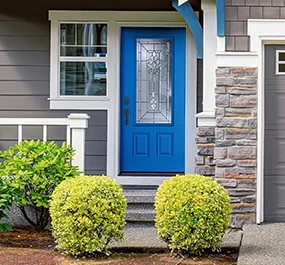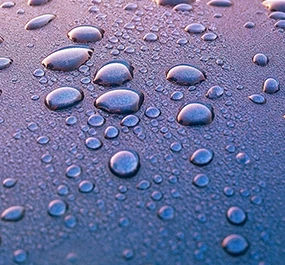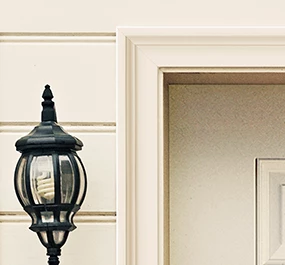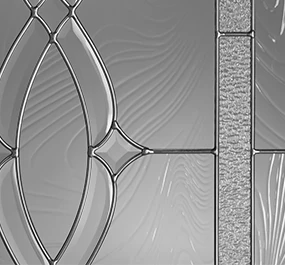The anatomy of a door isn’t always given much thought, with the focus often being on the material, curb appeal, and other more commonly discussed factors. However, knowing the exact anatomy of a door and door unit is helpful for front door home improvement projects, replacing any aspect of your entryway, and simplifying the buying process.
Key components in the anatomy of a door unit
There are three main aspects of a door’s anatomy: the door slab itself, the components that make a door unit, and add-ons. Let’s look at each component in detail.
The Door
Door slab
The slab is the main component of the door unit. This is usually made of a fiberglass, steel, or wood exterior and a core. For more on what goes into the core of the slab, we suggest referring to Plastpro’s Door Cores Comparison Guide.
Stiles
Stiles are the vertical components of the door slab. Stiles, alongside rails, often give the illusion of a single carved piece. Stiles are important—particularly their width—in the anatomy of a door as the door’s locks will usually be mounted near the stiles, and sometimes stiles are not wide enough for certain locking mechanisms. Note that the stile where the lock is located is often referred to as the lock stile, and the stile on the opposite side is called the hinge stile. Stiles—and rails—play an integral role in protecting the interior of the door from weather-related damage—especially water.
Rails
Rails are the horizontal component of the door slab, the top and bottom being differentiated as the “top rail” and the “bottom rail.” Rails play an important part in any hardware mounted close to them, as you’ll often have to take their measurements to ensure any connecting hardware (such as a kick plate) will fit properly.
It should be noted that what are considered the stiles and rails differ based on the type of door material used. For example, a flush wood door will not have stiles and rails. But for a paneled wood door, the interior area between the panels is also referred to as the stiles and rails. For doors that are pressed by a mold, such as steel or fiberglass, stiles and rails can also refer to the top and bottom, left and right encasing component pieces of the door.
Lock block
The lock block is the solid area on the interior of the door slab that is placed for a lock to be attached. The lock block is an important security consideration, as a lock will only function as well as the lock block it is attached to. Generally, the lock block will cover the 18-20” vicinity around the lock. However, Plastpro’s fiberglass doors feature a lock block that runs the length of the door to provide additional rigidity and support for the door, extra holding strength for the lock, and to accomodate any configuration of lock with no space constraints.
Door Unit
Sill
The sill sits underneath the door and connects to the frame on both sides of the door, set at an angle slanted down from the door to prevent unwanted dirt, debris, or bugs from making their way through any crevices. These are usually made of aluminum. The sill can also be referred to as the threshold.
Jamb/Frame
The jamb, or door frame, is actually composed of three pieces that frame the door. The left and right vertical pieces are referred to as side jambs, and the horizontal piece that sits at the top is called the head jamb. Depending on the homeowner’s preference, the jamb can be made of veneered wood, solid wood, or composite material. The material can influence the strength of the frame, which ultimately impacts security. Choosing a strong, durable material, such as a composite door frame, can improve front door security.
Moulding
Moulding, also known as trim or casing, is installed around the frame. While moulding does work to cover gaps in the frame, it also provides added beauty and personalization to the entryway. Moulding is available in a variety of styles to increase your front door curb appeal or accent your architectural style. In addition to aesthetic value, moulding can also offer protection to the entryway by preventing moisture infiltration into the door unit.
Door Add-Ons
Door Handle/Knob
The door handle is used to open and close the door. Door handles come in a variety of styles and finishes to complement your door and home. Many door handles also feature key cylinders and lock buttons used to lock and unlock the door.
Locking mechanism
A locking mechanism is what gives your exterior door its main point of security. The three main mechanisms used are a cylindrical lock, a mortise lock, and a multi-point lock. The cylindrical lock, one of the most common choices, is installed through a hole in the door slab. The mortise lock, which offers added security, is inserted into a hole cut into the side of the door. The multi-point lock, which has three points of locking security rather than one, is installed onto the side of the door with multiple points of locking.
Hinges
Hinges are pieces of metal hardware that start off separate from the door, but are attached to the door and the frame for a smooth and secure fit and swing. How you install the hinges is very important, as hinges are crucial to the tightness, and therefore, sealing of a door when it’s shut. Generally, three or four hinges are used for an exterior door.
Door sweep
The door sweep is usually connected to the underside of the door, which works with the weatherstripping to create the seal between the bottom of the door and the sill.
Weatherstrips
Weatherstrips are an external material (often foam, felt, rubber, or metal) that are attached to the outside of a door’s frame. This ensures that when the door is shut, it creates a seal that keeps out cold or hot air, bugs, and moisture. Weatherstrips are usually installed alongside the door sweep.
Deadbolt lock
The deadbolt lock, usually installed above the handle and its locking mechanism, offers extra front door security through a bolt that extends from the door into the frame by turning the key or its lock.
While there may be other components of doors depending on the intricacy of the door’s architectural style, which may call for the use of accessories, or the need to install specialty items like ADA hardware, these are the main components that make up the anatomy of a door. As exterior doors are meant to be secure and weather resistant, the quality of each separate component is crucial to the integrity of your door, and having a door that will stand the test of time.
The Plastpro difference
Plastpro takes pride in offering fiberglass doors that prioritize durability, security, and sustainability—aspects that are ingrained in each individual component of the door and door unit. From our long-lasting and durable fiberglass door slab, high-density polyurethane foam core, and innovative composite PF door frames, each element combines to form an entryway that is secure, weatherproof, energy efficient, and long-lasting—not to mention one that looks great too.
Thanks to our composite stiles, rails, and door frames, Plastpro is the only fiberglass door manufacturer in the U.S. that offers door units with no exposed wood, which lends our doors improved performance and durability. Where hardware is concerned, our full-length lock block allows for any lock of your choice for additional door security, and our selection of door accessories can add flair and create a door that is uniquely yours.
To find out more about how Plastpro can assist you with all your door needs, view our website, and find a dealer to purchase a door near you.



